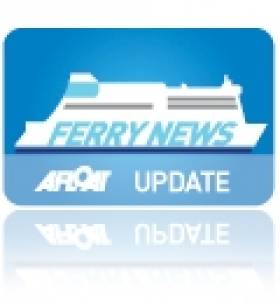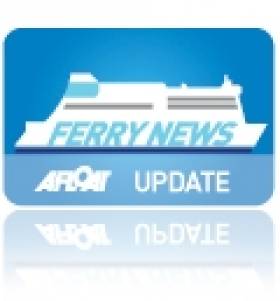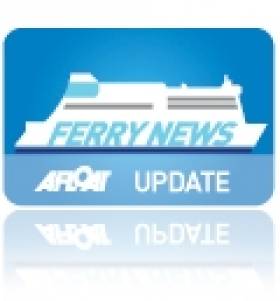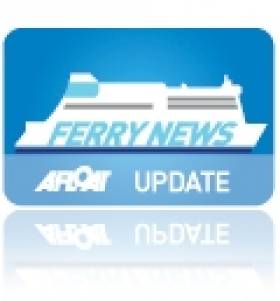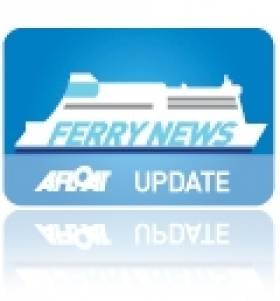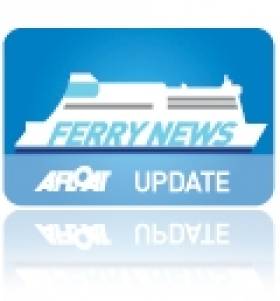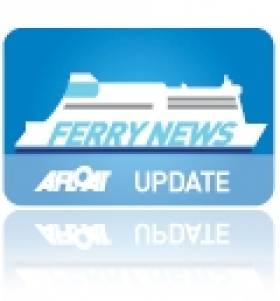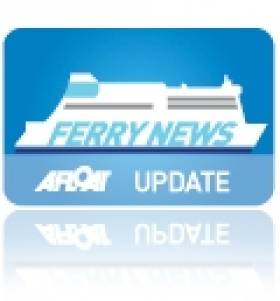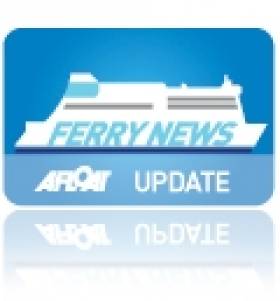Displaying items by tag: Irish Ferries
As Ulysses Returns Dublin ‘Swift’ Fast-Ferry to Go Off-Service
#DublinSwift- Ulysses departed Birkenhead fresh from annual maintenance today in readiness to resume a sailing from Holyhead in the early hours of tomorrow to Dublin Port, writes Jehan Ashmore.
During the dry-docking at Cammell Laird shipyard, the operators Rosslare-Pembroke Dock ferry Isle of Inishmore covered the roster of Ulysses in tandem with fast-fast Jonathan Swift.
Incidentally, all of Jonathan Swift's sailings were cancelled today apparently due to adverse weather conditions and these Dublin 'Swift' sailings are expected to operate tommorrow. Although Dublin 'Swift' sailings will not be operating from this Friday, 17 January to 7 February inclusively as the fast-ferry heads off for annual maintenance too.
With Dublin Swift sailings not running during that timeframe, the Dublin –Holyhead route will be maintained by Ulysses and newcomer Cartour Epsilon.
Epsilon’s Return to Dublin Port Marks Irish Ferries Launch Countdown of New French Service
#DublinCherbourg - Irish Ferries ro-pax Cartour Epsilon, returned to Dublin-Holyhead route duties today and this weekend she launches a new direct route from the capital to France, writes Jehan Ashmore.
Starting this Saturday, the once-weekly, year-round Dublin-Cherbourg operated route will connect the capital and the continent when the 500 passenger plus crew capacity car-ferry runs a weekend round-trip service to France in between serving weekday sailings to Wales.
Cartour Epsilon will be offering a low-fares economy-style service distinctly different from that operated by their Rosslare-French routes cruise ferry Oscar Wilde.
The new route sailing schedule will see departures from Dublin every Saturday (15.30) arriving into Cherbourg next morning (11.30). Return sailings will depart Cherbourg each Sunday (17.00) with early arrival back in Dublin on Monday morning (11.00).
Irish Ferries new route follows in the wake of another new service also running to France as LD Lines last week launched a 'landbridge' service to Spain from Rosslare to St. Nazaire with an onward connection to Gijón.
As previously reported, Cartour Epsilon had recently served sailings from Rosslare on Irish Ferries established service to Cherbourg during late December / early New Year period. Her absence leaves no ferry servicing the route until late February.
Although with the launch of the new Dublin-Cherbourg route, Irish Ferries will be able to maintain a service to France.
Following current duties on the Rosslare-Pembroke Dock route, Oscar Wilde is to take her turn of annual dry-docking in advance of resuming Rosslare-Cherbourg service next month as mentioned above.
Epsilon Enters Irish Ferries Service
#EnterEpsilon – Irish Ferries chartered ro-pax ferry Cartour Epsilon completed her commercial maiden voyage this morning, sailing between Holyhead and Dublin Port, writes Jehan Ashmore.
As previously reported, the delays of the Italian flagged ferry on entering Irish Sea service were due to 'operational reasons'.
Epsilon built in 2011, the 500 passenger and crew ferry brings an increase in capacity to cater for the seasonal boost in traffic as thousands of passengers return home for Christmas.
The 26,375 tonnes ro-pax offers two sailings in each direction each day, increasing to a maximum of 12 sailings daily, though currently high-speed craft sailings operated by Jonathan Swift are cancelled today due to the adverse weather conditions.
These Dublin Swift sailings operated by the fast-ferry are also cancelled for tomorrow. Alternative arrangements to transfer Jonathan Swift 'foot' passengers and motorists customers on different ships and information on sailing updates see this link.
Epsilon provides economy-style facilities featuring a bar, cafeteria, self-service restaurant, two and four berth cabins, free wi-fi service and 2,860 lane metres of vehicle deck parking space.
In addition to serving sailings to Wales, the 24-knot Epsilon will also launch a second route based from Dublin Port to Cherbourg on a year-round weekend-only service starting on 18 January 2014
‘Epsilon’ Delayed Debut on Dublin Service to Start Next Week
#Epsilon – Irish Ferries cite fleet dry-docking and 'operational reasons' for the delays in introducing 'Epsilon' which is to boost additional peak capacity over the Christmas season, writes Jehan Ashmore.
As previously reported, Epsilon was to have made her debut this week on the core Dublin-Holyhead route, bringing thousands of seasonal passengers home and overseas visitors to our shores.
Epsilon is not expected to start operationg until next week (Tuesday 17 Dec.) with the 01.55 sailing departing from Ireland. She will provide additional sailings by operating two-round trips daily, which increases to a maximum of 12 sailings daily on the Dublin-Holyhead route.
The 26,375 tonnes ro-pax with space for around 500 passengers will join fleetmates, Ulysses and fastcraft Jonathan Swift and together the trio will provide a maximum of 12 sailings each day.
Epsilon's entry as third route ship will extend beyond New Year sailings too as the 186m long vessel is on charter for the next three years. During this timefrane she will also operate Dublin-Cherbourg route service starting 18 January.
New Third Dublin Route Ferry Completes Repositioning Voyage from Italy
#EpsilonArrives– Epsilon's first visit to Dublin Port last night completes the end of her repositioning voyage from Sicily last week, which included a call via Gibraltar, writes Jehan Ashmore.
The three-year charter of Epsilon to Irish Ferries is expected to see the 500 passenger ro-pax introduced as the third vessel on the Dublin-Holyhead in the run-up to the busy Christmas season.
Epsilon is to provide two additional departures daily in each direction which will increase sailings to a maximum of twelve serving the core Irish Sea route.
The 2011 built Epsilon which docked this morning at Ocean Pier, a temporary berth, is set to join the routes flagship cruiseferry Ulysses and fastcraft Jonathan Swift. Unlike her fleetmates, Epsilon will not however be catering for 'foot' passengers on any of her sailings.
In addition to the Epsilon sailing on the Irish Sea, the 26,325 tonnes ferry is to launch in the New Year, a new direct service to France between Dublin-Cherbourg starting on 18 January 2014.
The year-round operated continental route will be served only at weekends, when a round-trip sailing schedule will provide a link between the Irish capital and Normandy.
French Routes Ro-Pax Rival Sisters Meet in Rosslare Harbour
#NewFerry – Irish Ferries chartered ro-pax Epsilon called to Rosslare Europort from Cherbourg this morning, her arrival to Irish waters follows a repositioning voyage starting almost a week ago from Sicily, writes Jehan Ashmore.
Under the command of Captain Paul Sellers, Epsilon approached the Wexford ferryport from where Irish Ferries Pembroke Dock bound Isle of Inishmore vacated her berth for the newcomer.
Ironically at the adjacent berth to where Cartour Epsilon (2011/26,325grt) berthed was Celtic Horizon (2006/27,522grt) of Celtic Link Ferries which in 2011 entered service on their service to Cherbourg. She is a sister and former fleetmate which as Cartour Beta also served Italian operator Charonte & Tourist.
Epsilon's call to the Wexford port was likewise to Cherbourg to carry out berthing trails when Irish Ferries requires relief cover on southern services.
She is due to make the final leg of her journey to Dublin Port to where the ro-pax ferry is to enter service on the Holyhead route this week and in the New Year launch a new Dublin Port-Cherbourg route.
Also berthed in Rosslare Harbour was Stena Europe, the Fishguard route ferry which was fresh from annual maintenance following dry-docking in Birkenhead.
New Ferry ‘Epsilon’ Underway on Final Leg to Irish Waters
#NewFerry – 'Epsilon' Irish Ferries new ro-pax ferry continues her voyage to Ireland as she rounds Land's End tonight having called today to Cherbourg for berthing trials, writes Jehan Ashmore.
The call to Normandy represents the first of three ports that she will serve on her two-route roster which sees the 2011 built ferry firstly make her debut between Dublin-Holyhead later this week.
The second route in which Epsilon is to be deployed, Dublin-Cherbourg will be run on a year-round basis. The economy-style service will cater for motorist based passengers and for freight vehicle customers, albeit foot passengers will not be carried.
Epsilon's call to Rosslare Harbour is due for berthing trails, as Irish Ferries intend that the Italian flagged newcomer also provide relief cover on sailings from the Wexford port.
Captain Paul Sellers who has charge of the chartered ferry which departed Sicily last week, will be back in local waters as he is a master of the Isle of Inishmore which serves Irish Ferries route to Pembroke Dock.
The operator's second ship running from Rosslare Harbour is the French routes cruiseferry, Oscar Wilde which is currently maintaining added capacity as the third ship on the Dublin-Holyhead route.
She is expected to return to Rosslare-Cherbourg sailings later this week, pending the smooth introduction of Epsilon further north between the Irish capital and Anglesey.
#NewFerry – 'Epsilon' the new ro-pax ferry on charter to Irish Ferries is currently off the Portuguese coast heading to Cherbourg for berthing trials, prior to making her debut on the Irish Sea, writes Jehan Ashmore.
The Italian flagged 26,375 tonnes vessel is under the charge of Capt. Paul Sellers, a master of the Rosslare-Pembroke Dock route vessel Isle of Inishmore.
Earlier this week as previously reported, she departed Messina, Sicily on her repositioning voyage to Irish waters and so far this has involved a call to Gibraltar for bunkers.
The newcomer was previously on charter as Cartour Epsilon to Caronte & Tourist service between Italy and Sicily. The 500 passenger and crew ferry will also make en-route ports of call to carry out berthing trials in Rosslare and Holyhead.
Epsilon is scheduled to launch her sailings between Dublin-Holyhead next week.
In the meantime Oscar Wilde which is off service from the French route to Cherbourg is covering the Dublin-Holyhead route until Epsilon takes over the same roster in a boost to capacity as the third ship on the route.
In mid-January 2014, Epsilon also launches a new Dublin-Cherbourg route where she will operate at weekends a round-trip schedule in addition to maintaining weekday sailings on the Dublin-Holyhead route
Irish Ferries New Chartered Ferry ‘Epsilon’ on Repositioning Voyage
#NewFerry – Epsilon the new ro-pax ferry which Irish Ferries has secured a three-year charter contract for Irish Sea and French operations, is underway in the Mediterranean Sea on a repositioning voyage bound for Irish waters, writes Jehan Ashmore.
The 2011 built 26,375 tonnes ro-pax ferry is to be introduced firstly on the core Dublin-Holyhead route, boosting capacity as the third vessel in advance of the busy festive season.
In addition to providing daily weekday Irish Sea sailings, from mid-January 2014 she is also to launch a new year-round Dublin-Cherbourg route every weekend, departing the capital on Saturdays and returning on Monday mornings.
Completed by Cantiere Navale Visentini, Italy as Cartour Epsilon, she represents one of more than 20 similar vessels of this ro-pax design which has proven popular in the charter market.
The 500 passenger and crew vessel has been on charter to Caronte & Tourist running between Italian west coast ports and Sicily, from where she departed Messina yesterday and is currently in waters south-west of Sardinia.
Cartour Epsilon is due to call for bunkers in Gibraltar tomorrow night and this route to the UK overseas territory follows that of a sister, Cartour Beta. As AFLOAT.ie reported more than two years ago she sailed off the Algerian coast having departed Palermo and a call to Gibralter before reaching Rosslare Harbour under her new name Celtic Horizon.
The 2006 built Celtic Horizon is also on a three-year charter arrangement from her shipbuilder-owners to Wexford based Celtic Link Ferries which operates to Cherbourg.
When 'Epsilon' enters service this month in the run up to the busy festive period on the core Dublin-Holyhead route, passengers will have economy style facilities on board that include a bar, cafeteria, self-service restaurant, two and four berth cabins and free wi-fi service. In addition the ro-pax will boost vehicle deck space of approximately 2,860 lane metres.
Irish Ferries are to market the Dublin-Cherbourg route to an economy-style service as she differs considerably when compared to cruiseferry style facilities and a broader range of cabins available on board Oscar Wilde.
The new French route will augment the cruiseferry operations of the Oscar Wilde on the Rosslare-Cherbourg route and seasonal only service to Roscoff.
#France-Ireland - Minister for Transport, Tourism & Sport Leo Varadkar has welcomed a new direct French ferry route linking Cherbourg to Dublin as good news for Irish tourism and will build on the success of The Gathering.
"This weekly ferry route from Cherbourg to Dublin will provide tourists from France and mainland Europe with a direct car link into the capital. It will help us to build on the success of The Gathering in promoting Ireland as a visitor destination.
"Ireland is well catered for in terms of aviation access, and new aviation routes are announced on a regular basis. But as an island it's important that we give visitors plenty of options to bring their cars as well. Tourists on driving holidays tend to stay longer than those who fly, and are more likely to travel around the country."


























